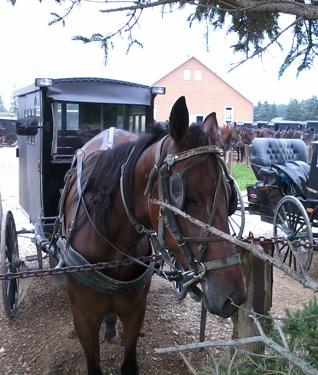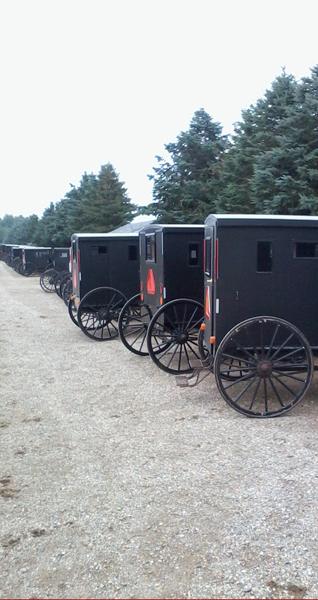Travel
Simple Thanks
by T. SHER SINGH
The area I live in here in Ontario, Canada, has gradually and progressively become the heartland of the Mennonite Christians, not unlike, for example, a similar area around Amish settlements in Pennsylvania south of the border.
Simply passing through this area to cottage country, for example, the countryside looks no different … an undulating expanse of farmland, punctuated by farmhouses, barns, open fields laden with crops of a variety of hues, rolls and bales of hay, and animals basking in the sun.
You only notice the wide shoulders on either side of the highway if someone points them out to you. They are for the black horse-drawn buggies exclusively used by Mennonites for transportation. You might even occasionally drive by a couple or family in a buggy - a contrast as stark as any you’ll see in, say, India, between a scooter rickshaw and a bullock-cart on the main street.
The difference here, in the case of the Mennonite, is that he has chosen this lifestyle for its stark simplicity, as required by his faith.
I am a few dozen miles from home on an errand in the thick of farming country, off the main road, when I pass by a large warehouse-like building. Parked outside it, in neat rows, are over a hundred black buggies, their horses still tethered to them in silent meditation.
It’s the first day of the final summer month, I remind myself, and mid-day on a Thursday too. A pretty unusual scene for the mid-week. Probably a funeral, I say to myself, as I drive on.
I go through a village and then see another such building. Again, a phalanx of buggies and horses standing outside it. This is the height of the short farming season we have. Another funeral?
It’s unusual enough to prompt me to stop at the next business establishment I notice by the roadside and enquire. A blacksmith, he shakes his soot-smudged head and agrees: strange and unusual! But has no clue.
My curiousity aroused, I simply cannot resist stopping at a cross-road a mile or two away: a repeat of the two scenes I have driven by only minutes earlier.
It’s a beautiful, warm summer day. Dressed in a light-coloured turban, a chequered bush-shirt, khaki shorts, and a pair of sandals, I am not averse to stepping out in the sun on the slightest excuse to nose around.
I park on the dirt side-road, right next to the fence. Scores of horses interrupt their munching to look at me nonchalantly, and then pretend to get back to their private musings, as I walk by.
There is no gate. As I negotiate my way past the horse-droppings, I notice that there isn’t a sign anywhere to describe or proclaim the building.
But I know, from tips received from a friend, that this is a Mennonite church.
It’s a longish building stretching out to almost a hundred feet. A few young women in long dresses, heads and hair-buns covered in neat little white-lace head-coverings are occupied with babies and toddlers.
So I head to the opposite end of the building, far on the other side, remembering my friend’s tip that there’ll be four separate entrances, one each for younger women (girls) and the older ones at one end, and for young men (boys) and adult men on the other.
As I turn the corner at the other end of the building, I see a lone male figure with a young boy beside him.
He’s taken aback by the sheer sight of a stranger. He’s dressed in black, head to toe, except for a white, collarless shirt, buttoned tightly at his neck. So is the child, around 4 years or so, except he also has a bow-tie. Both are bare-headed.
I ask him about the gathering. He explains in a muted voice: it’s a day of thanksgiving for the Mennonites. Hence the church service.
“Can I go in?“
He shrugged his shoulders. “Why not?” is how I read it, in my eagerness to see more. “Where do I go in?” He points to a door, half open, about twenty feet away.
I wish him ’Happy Thanksgiving!’ He takes it with a bit of a surprised look, but nods his ’thank you’ and stares after me as I venture towards the door.
When I reach the entrance and look in, I suddenly hear a lone voice speaking somewhere deep within. My eyes haven’t had the time to adjust from the bright sun to the muted indoors. Though it’s a dark, cavernous expanse that I see before me, I quickly begin to realize that hundreds of pairs of eyes are looking at me.
It is at this moment, as my own eyes begin to adjust, that I think of the sight they are being confronted with. Here I am, standing in the blinding light of the open door before a sea of black-suited figures; they can’t see my details, but they can see a man in a turban, bearded, t-shirted, in shorts, bare-legs ending at my sandals.
Panic hits me. I freeze. The voice from within the hall falters for a few seconds, and then plods along. My eyes and the multitude eying me, we grapple with our respective apparitions before us.
The only words that come to my mind now, as I think back on those moments, is: though already silent, we had been struck speechless!
I stand there helplessly as I notice a bench of men beginning right in front of me, along a seemingly endless aisle running away from the door.
I hear a shuffle of feet. One man lifts a child from his lap, plunks her on the seat and approaches me.
“Can I help you?” he whispers.
“I want a seat,” is all I can blurt out.
He looks around, and finally points in a direction behind him. I feel life in my limbs again. I walk past him, and try and focus my eyes. I see another aisle to my left … and a few rows behind, an empty seat. As I approach it, a number of figures shift and slide to make room at the end of the bench.
I sit down.
I am surrounded by several hundred faces, seated in neat rows. In front of me, facing left, towards the centre of the hall, are several rows of men. At right angles to them are the rows that I am in … also full of men, but progressively, as the rows approach the centre, they are filled with younger men and boys.
All the males are in black or dark blue suits, white shirts, black shoes. Not a whisker on any face or chin, young or old. Each bare-headed. Immediately above them are pegs holding their hats, one for each one of them.
Next to them and facing the same way, all the way to the end of the length of the hall, are pews with girls and young women. They are the only ones who display some colour, albeit dark solids and floral prints. The young girls have their hair in two braids, the older ones have their hair-buns tucked into white-lace 'kapps' - head-coverings which are mini-versions of the bonnet. Long black stockings, black shoes.
At the extreme end are the women with babies, obviously for easy access to the door for a quick exit. Every now and then, a baby makes a plea and the mother whisks her out.
Facing these young women, at right angles to them and facing to the right - towards the centre and the older men on the far side - are the women in black. Older women, all, dressed in long black dresses, some with capes covering their shoulders. And white kapps.
At the centre of it all, against the long wall facing us all, is a slightly raise dais. A short wooden partition, no more than three feet high, and behind them are five grim-looking faces. Four are seated on a bench; one is standing before a lectern with a bible open before him, giving a sermon.
Three of them, I’m told later, are ministers; two are deacons. They are seated in accordance with seniority, which is primarily based on age. The ministers to the left, then the deacons.
I already know that Mennonites do not do anything special or different on “special days”. Thus, a regular service on Sunday is no different from the service on Christmas Day or Easter.
That explains why I had come across no brouhaha anywhere, even though I was deep in Mennonite country, that this was Thanksgiving day. No banners, no fairs or street-fests, no sales, no corn-wreaths … No parades. No need to proclaim anything to the world.
The only thing they do is take time off from their farms and workshops and attend a normal, quiet, private church service, just like the one I am sitting in.
I am conscious of the fact that I have disrupted things a bit.
I find I am sitting in the midst of what appears to be a couple of hundred children. Not all the discipline in the world - and this community has nothing if it doesn’t have discipline - can keep their blonde heads from swinging around, their wide blue eyes flickering in my direction.
They are all of Germanic extraction, their faces grim and weather-beaten. Clean and groomed, but not a trace of ornament or ostentation.
The minister giving the sermon struggles through the next few minutes, until things gradually calm down and return to normal.
But throughout the commotion, there hasn’t been a word, a whisper, from anyone. Nor at any time during the hour and a half that I was there. The usual fidgeting, yes, in the younger aisles, but total law and order reigns, as the minister continues.
The minister breaks into a few words and phrases of English every now and then, but even then, his accent is thick and impermeable. All in the congregation, I already know, would speak fluent German and English. This being an ‘Old Order Mennonite‘ congregation, the service is entirely in German … but for the brief words in English which, I was told later by the minister, were graciously for my benefit alone.
I look around and see that other than the pews, the ministers’ partition and lectern, and the hat-peg racks suspended from the ceiling over the men‘s heads, and the windows and doors - all in a natural, honey colour varnish - there is nothing else to break the monotony.
There is no colour.
No signage. No slogans. No proclamations. No verses. Not a word written anywhere.
No cross or any kind of symbol.
No stained glass. The windows - the only source of light and ventilation - are open.
No pictures. No idols or statues. No photographs. No images.
No plaques. No memorials. No certificates. No testimonials.
No names of ministers, past or present. No ’honour lists’ of martyrs. Or donors.
No electricity, no artificial lighting. No candles.
No microphones, or voice amplification of any kind.
No altar.
No air-conditioning.
No musical instruments. No music.
The sermon remains monotone. There are no interjections by anyone. Or any exhortations to the congregation for collective hallelujahs. No affirming ‘Amens‘.
Time flies for me since I have so much to soak in as my eyes wander. It is easy because after the initial commotion, I am being completely ignored. Even the kids seem to have lost interest in the intruder and are as attentive to the service as their little energy-filled bodies will allow.
The sermon ends. The congregation breaks into song.
First the men. In slow, measured cadences. The women then take over, as if on cue. The children join their respective sides. Sometimes, a back and forth, sometimes they sing with each other. At other times, in waves over each other.
Like the sermon, the words mean nothing because they are all in German. I still find them soothing and comforting. And spiritually uplifting.
Poetry and music are no slaves to understanding. Sometimes I feel the mind merely interferes. Therefore, if it is an impregnable foreign language, it merely short-cuts into the heart and the soul.
I like what I hear. And I like the faces, intense in devotion, singing a cappella. They are in perfect chorus, even though no conductor guides them. There is no lead or leader. It seems to emanate naturally and flows effortlessly from one end of the church to the other.
I remember my father used to say: there’s an inherent beauty to true devotion, which no amount of ornamentation can augment, enhance or replace.
The serenity that pervades the hall settles over me.
I am not bothered by not having a clue to what’s going on around me. Or by the fact that I am alone, surrounded by men and women of a completely different faith, with completely different beliefs and practices.
I have my head covered. Each of the men around me has made it a point to uncover his head.
I sport unshorn hair and a never-trimmed beard. I am surrounded by clean and polished chins.
I automatically break into a smile when I feel a surge of high go through me. I am surrounded by faces that are etched in grim stone-like lines, their humility expressed through sculpted profiles.
The singing fades away. A few moments of silence. Then, one by one, each of the remaining ones on the minsters’ and deacons’ bench says a few words.
Then, on a cue I didn’t catch, the whole hall drops on its knees and swivels to face the backs of the benches … that is, everyone is now slumped over their seats, with their backs to the ministers and to each other.
Their heads remain down and motionless. A total silence has ascended on the congregation. As the minutes tick by, my thoughts go back to the Friday evening gatherings a dozen Sikh families, including ours, would have back in Patna, taking turns at a different home each week.
We had a simple service at our homes then, even though a gurdwara was always close by, and the magnificent Takht was but a few miles away. Followed by a home-cooked meal together. There was a magic to the smallness and the simplicity.
I raise my head and look around me.
Is this the devotion experienced by man before places of worship turned into palaces?
Each one around me is in a kind of bana, and yet it’s not paraded as a badge of honour, or lays claim to a status which otherwise has to be earned, or a costume, a weapon.
What each one is wearing here is no more than an expression of pure humility and surrender.
There is much that I know about Mennonites that I do not agree with and would never want to emulate.
Yet, I feel at home with them. Sitting amongst them, I feel connected with my Sikhi as I seldom am elsewhere.
Walking into that congregation that day, I felt like I had shed my shoes outside, washed my feet, covered my head in humility, and had checked my bag of pretensions and ostentations, language and intelligence, outside.
And walked in, a naked soul.
September 9, 2011
Conversation about this article
1: Harinder (Uttar Pradesh, India), September 09, 2011, 1:23 PM.
Sir, you must write a book on "Mennonites".
2: Gurmeet Kaur (Atlanta, Georgia, U.S.A.), September 09, 2011, 2:18 PM.
Soul soothing! "Is this the devotion experienced by man before places of worship turned into palaces?" Your words are worth a thousand pictures.
3: Baljit Kaur (Los Angeles, California, U.S.A.), September 09, 2011, 3:43 PM.
This story is a plea for Sikhs to understand that the strength and beauty of Sikhi lies in its simplicity. The rest is all "neti, neti, neti!" You have left me shaken to the core.
4: Sangat Singh (Kuala Lumpur, Malaysia), September 09, 2011, 8:28 PM.
How to sufficiently express a simple thanks to you, Sher ji, for such an exquisite peep for accidently wandering into a pocket of Mennonite culture that seems so foreign in the present-day world. It was a picture of "sadh sangat". Your piece has left me absolutely amazed. English is no longer a foreign language. It has been adopted, nurtured and brought up like its your own. Thanks for taking us on that trip. We shall "grapple thee to our souls with hoops of steel" (Hamlet - adapted). Reminds me when the finest and thinnest Japanese piece of steel wire was presented to our famous Ludhiana Foundry to see if they could improve upon it. A day later it was returned with finely inscribed "Made in Ludhiana by Gurmukh Singh & Sons".
5: M. Kaur V (New York, U.S.A.), September 09, 2011, 11:30 PM.
Silence speaks with a thousand words and the silence of the Mennonites led to your beautiful words. Thank you for your gloriously inquisitive foray into the unknown. May Waheguru keep leading you to efforts that cause all your readers to bask in the sheer exhilaration of your journeys. Thank you.
6: Raj (Canada), September 10, 2011, 7:48 PM.
The imagery T. Sher Singh uses is very powerful. Thanks for this beautiful article. We have a few such colonies in Alberta. They come to our work to sell their produce. Like T.Sher Singh, I find them a very peaceful and graceful people.
7: Harbans Lal (Dallas, Texas, U.S.A.), September 11, 2011, 12:58 AM.
A soothing narration which was very informative.
8: Nav Kaur (Australia), September 12, 2011, 1:41 AM.
T. Sher Singh ji: you have done an incredible job in taking us on this journey of simplicity. Through this powerful journey, you have expressed the beauty of devotion, spirituality and, above all, humanity.






